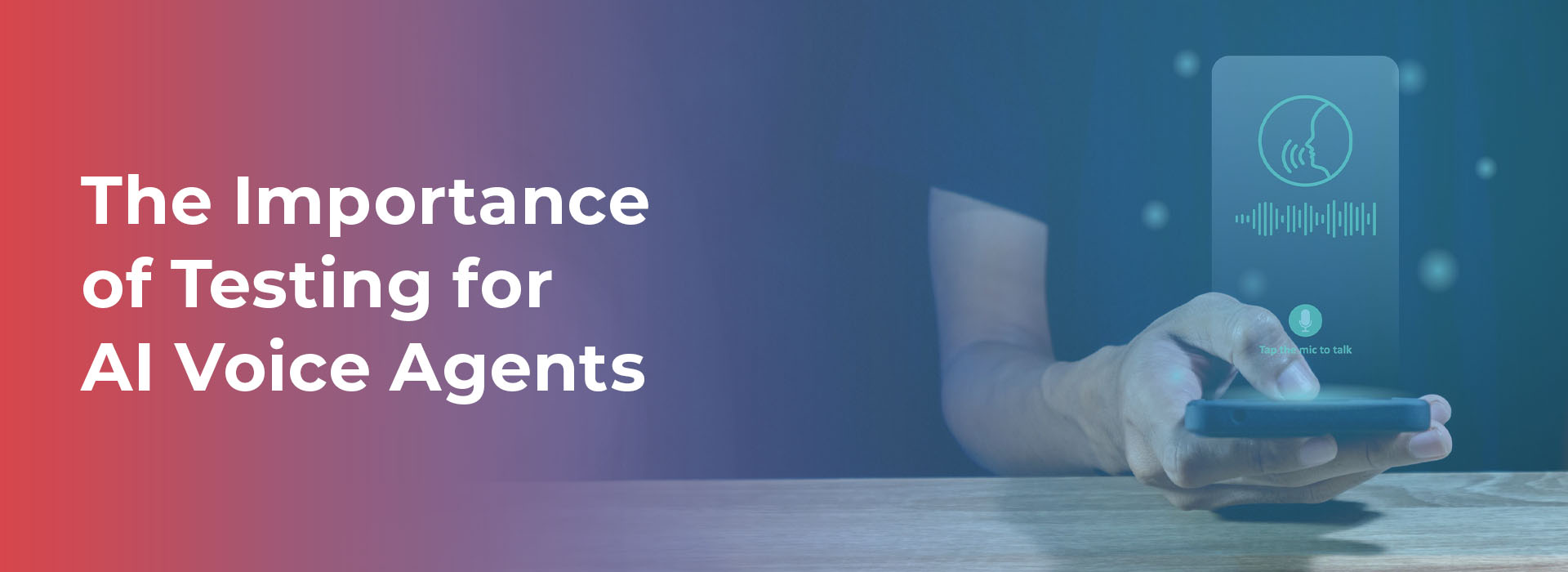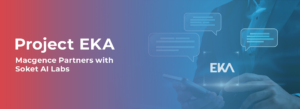The Importance of Testing for AI Voice Agents
From asking “What’s the weather today?” to control smart home devices with just a voice command, AI voice agents have revolutionized the way we interact with technology. With voice-based systems like Alexa, Siri, and Google Assistant becoming integral to our daily lives, their seamless performance is no longer a luxury but an expectation. However, behind their intuitive replies and flawless operations lies a crucial aspect that often goes unnoticed—testing for AI voice agents.
Through rigorous testing, these agents are bound to obey user requirements while ensuring the security and ethical standards of the application. In this blog post we will analyze the reasons for the thorough testing, the employed testing strategies, the tools and frameworks, the best practices to observe, and the potential of the technologies.
Why Testing for AI Voice Agents is Crucial
Thorough testing is the foundation of high-functioning AI voice systems. But why does it matter so much? Here’s why Voice AI Agent Testing is indispensable to the development process.
1. Ensures Functionality
AI voice agents rely heavily on natural language processing (NLP) and machine learning (ML) to interpret and respond to human requests. Errors in their functionality—like misinterpreted commands or inappropriate responses—can break the user experience. Functional testing ensures the AI voice agent delivers accurate and reliable responses in various scenarios.
2. Improves User Experience
Envision a scenario where every conversation with an AI voice agent was riddled with confusion and delayed responses. Such negative perceptions can greatly hinder an AI agent from gaining the necessary trust and goodwill from its users. User testing can be defined as the best way to gain the temporary faith and goodwill as it seeks to test whether the agent’s voice truly gras them.
3. Secures Sensitive Data
AI voice agents process sensitive personal data—think bank passwords or healthcare information. Without rigorous security testing, systems are vulnerable to data breaches, posing threats to user privacy and safety. Testing identifies vulnerabilities and strengthens the voice agent against cyberattacks.
4. Builds Ethical AI
Testing also ensures voice agents adhere to ethical standards. For instance, testing eliminates bias from the voice agent’s responses, ensures accessibility for individuals with speech peculiarities, and makes sure the AI complies with local laws and regulations.
Types of Testing for AI Voice Agents

Different types of testing serve different purposes. Here’s a deep dive into the four main categories of Testing for AI Voice Agents.
1. Functional Testing
This process assesses whether the AI voice agent performs as expected by validating inputs and outputs. For example:
- Testing how the agent responds to multiple accents.
- Ensuring integration with third-party APIs or smart home devices.
2. Performance Testing
Assessing speed, uptime, and how well the agent handles high volumes of requests falls under performance testing. A few critical aspects tested:
- Latency when responding to user requests.
- Scalability to manage traffic spikes.
3. Security Testing
Security testing focuses on protecting sensitive user data. Some key areas include:
- Preventing unauthorized access to data.
- Safe handling of sensitive input such as voice recordings or biometric data.
4. Usability Testing
The goal here is to ensure the voice agent is intuitive and accessible for all users. Testers check for:
- Ease of understanding across various accents and speech patterns.
- Accessibility for users with disabilities, like stuttering.
Tools and Frameworks for Testing AI Voice Agents
Testing AI voice agents has been streamlined by the rise of advanced tools and frameworks. Below are some of the most popular ones.
1. Rasa
An open-source framework for building conversational AI. Its testing features include dialogue simulations, stress testing, and automation to identify potential errors.
2. Google Dialogflow
Ideal for testing chatbots and voice interfaces, Dialogflow provides effective monitoring and debugging tools for conversational AI workflows.
3. Botium
A go-to testing tool for chatbots and voice AI, Botium includes options for functional, regression, and performance testing.
4. Rainforest QA
This tool specializes in manual and automated testing for voice applications, with robust support for NLP systems.
At Macgence, we pride ourselves on providing high-quality testing datasets that help optimize the performance of AI models, including voice agents.
Best Practices for Testing AI Voice Agents
Adopting effective methodologies significantly impacts your testing outcomes. Here are the best practices for Voice AI Agent Testing to keep in mind.
1. Simulate Real-Life Scenarios
Test your voice agent in different environments, including noisy and quiet settings, to monitor how external factors affect its performance.
2. Prioritize Data Diversity
Train and test the voice agent using a diverse set of datasets to account for variables like regional dialects, accents, and non-native speakers.
3. Automate Where Possible
Automated testing tools can drastically cut down effort and time associated with repetitive tasks, leaving more time for exploratory testing.
4. Monitor Ethically
Testing must ensure the AI complies with data protection laws, avoids bias, and respects user privacy.
5. Test Across Devices
AI voice agents are embedded in various devices, from smartphones to smart speakers. Ensure your testing covers compatibility across all such platforms.
The Future of AI Voice Agents
The capabilities of AI voice agents will only grow from here—so will the challenges of testing them. Future advancements will include:
- Personalized Interactions using deep user profiles to tailor responses.
- Emotion Detection to improve engagement and empathy.
- Zero-Latency Responses driven by the use of edge computing.
The testing landscape will also evolve, shifting toward more continuous, real-time testing methods that sync with the dynamic learning behaviors of these agents.
Why Thorough Testing Powers the Future of AI Voice Agents
Testing is not just a technical necessity—it’s the backbone of user trust in voice AI technologies. Whether it’s ensuring seamless functionality, bolstering security, or advancing user experience, testing helps voice agents evolve into reliable and advanced tools. At Macgence, we take pride in providing end-to-end data solutions for testing and training AI/ML models, shaping the future of AI technology. Interested in elevating your AI testing process? Visit Macgence today to access rich datasets and expert services.
FAQs
Ans: – Testing challenges include ensuring accuracy across multiple languages, eliminating bias, and securing sensitive data while building models that adapt to various use cases.
Ans: – Testing helps eliminate bias, enhances accessibility, and ensures agents act in accordance with global ethical and legal standards.
Ans: – Diverse datasets improve the accuracy of voice agents across accents, dialects, and speech patterns, enhancing inclusivity and usability.
You Might Like
February 28, 2025
Project EKA – Driving the Future of AI in India
Spread the loveArtificial Intelligence (AI) has long been heralded as the driving force behind global technological revolutions. But what happens when AI isn’t tailored to the needs of its diverse users? Project EKA is answering that question in India. This groundbreaking initiative aims to redefine the AI landscape, bridging the gap between India’s cultural, linguistic, […]
March 7, 2025
What is Data Annotation? And How Can It Help Build Better AI?
Spread the loveIntroduction In the world of digitalised artificial intelligence (AI) and machine learning (ML), data is the core base of innovation. However, raw data alone is not sufficient to train accurate AI models. That’s why data annotation comes forward to resolve this. It is a fundamental process that helps machines to understand and interpret […]
March 6, 2025
Vertical AI Agents: Redefining Business Efficiency and Innovation
Spread the loveThe pace of industry activity is being altered by the evolution of AI technology. Its most recent advancement represents yet another level in Vertical AI systems. This is a cross discipline form of AI strategy that aims to improve automation in decision making and task optimization by heuristically solving all encompassing problems within […]
March 5, 2025
Use of Insurance Data Annotation Services for AI/ML Models
Spread the loveThe integration of artificial intelligence (AI) and machine learning (ML) is rapidly transforming the insurance industry. In order to build reliable AI/ML models, however, thorough data annotation is necessary. Insurance data annotation is a key step in enabling automated systems to read complex insurance documents, identify fraud, and optimize claim processing. If you […]


 Previous Blog
Previous Blog







